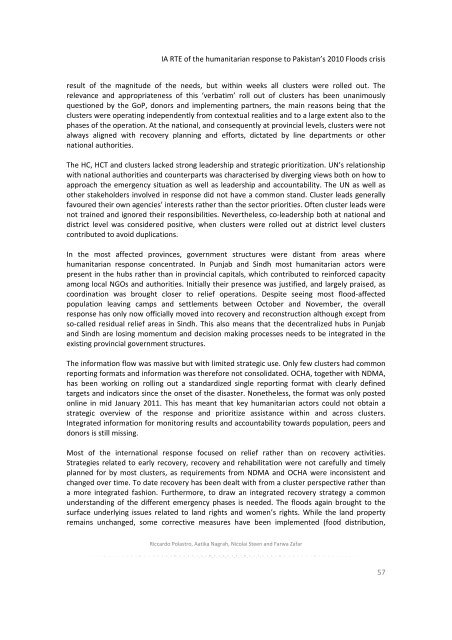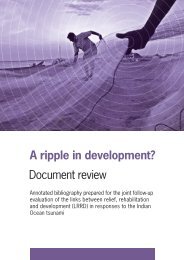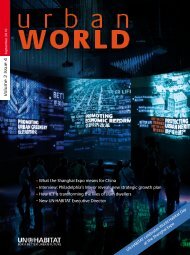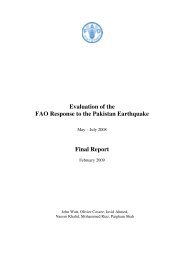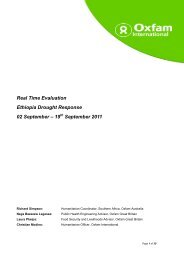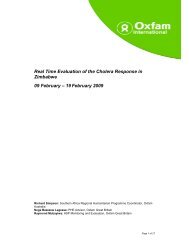Inter-Agency Real Time Evaluation of the Humanitarian ... - alnap
Inter-Agency Real Time Evaluation of the Humanitarian ... - alnap
Inter-Agency Real Time Evaluation of the Humanitarian ... - alnap
You also want an ePaper? Increase the reach of your titles
YUMPU automatically turns print PDFs into web optimized ePapers that Google loves.
IA RTE <strong>of</strong> <strong>the</strong> humanitarian response to Pakistan’s 2010 Floods crisis<br />
result <strong>of</strong> <strong>the</strong> magnitude <strong>of</strong> <strong>the</strong> needs, but within weeks all clusters were rolled out. The<br />
relevance and appropriateness <strong>of</strong> this ‘verbatim’ roll out <strong>of</strong> clusters has been unanimously<br />
questioned by <strong>the</strong> GoP, donors and implementing partners, <strong>the</strong> main reasons being that <strong>the</strong><br />
clusters were operating independently from contextual realities and to a large extent also to <strong>the</strong><br />
phases <strong>of</strong> <strong>the</strong> operation. At <strong>the</strong> national, and consequently at provincial levels, clusters were not<br />
always aligned with recovery planning and efforts, dictated by line departments or o<strong>the</strong>r<br />
national authorities.<br />
The HC, HCT and clusters lacked strong leadership and strategic prioritization. UN’s relationship<br />
with national authorities and counterparts was characterised by diverging views both on how to<br />
approach <strong>the</strong> emergency situation as well as leadership and accountability. The UN as well as<br />
o<strong>the</strong>r stakeholders involved in response did not have a common stand. Cluster leads generally<br />
favoured <strong>the</strong>ir own agencies’ interests ra<strong>the</strong>r than <strong>the</strong> sector priorities. Often cluster leads were<br />
not trained and ignored <strong>the</strong>ir responsibilities. Never<strong>the</strong>less, co‐leadership both at national and<br />
district level was considered positive, when clusters were rolled out at district level clusters<br />
contributed to avoid duplications.<br />
In <strong>the</strong> most affected provinces, government structures were distant from areas where<br />
humanitarian response concentrated. In Punjab and Sindh most humanitarian actors were<br />
present in <strong>the</strong> hubs ra<strong>the</strong>r than in provincial capitals, which contributed to reinforced capacity<br />
among local NGOs and authorities. Initially <strong>the</strong>ir presence was justified, and largely praised, as<br />
coordination was brought closer to relief operations. Despite seeing most flood‐affected<br />
population leaving camps and settlements between October and November, <strong>the</strong> overall<br />
response has only now <strong>of</strong>ficially moved into recovery and reconstruction although except from<br />
so‐called residual relief areas in Sindh. This also means that <strong>the</strong> decentralized hubs in Punjab<br />
and Sindh are losing momentum and decision making processes needs to be integrated in <strong>the</strong><br />
existing provincial government structures.<br />
The information flow was massive but with limited strategic use. Only few clusters had common<br />
reporting formats and information was <strong>the</strong>refore not consolidated. OCHA, toge<strong>the</strong>r with NDMA,<br />
has been working on rolling out a standardized single reporting format with clearly defined<br />
targets and indicators since <strong>the</strong> onset <strong>of</strong> <strong>the</strong> disaster. None<strong>the</strong>less, <strong>the</strong> format was only posted<br />
online in mid January 2011. This has meant that key humanitarian actors could not obtain a<br />
strategic overview <strong>of</strong> <strong>the</strong> response and prioritize assistance within and across clusters.<br />
Integrated information for monitoring results and accountability towards population, peers and<br />
donors is still missing.<br />
Most <strong>of</strong> <strong>the</strong> international response focused on relief ra<strong>the</strong>r than on recovery activities.<br />
Strategies related to early recovery, recovery and rehabilitation were not carefully and timely<br />
planned for by most clusters, as requirements from NDMA and OCHA were inconsistent and<br />
changed over time. To date recovery has been dealt with from a cluster perspective ra<strong>the</strong>r than<br />
a more integrated fashion. Fur<strong>the</strong>rmore, to draw an integrated recovery strategy a common<br />
understanding <strong>of</strong> <strong>the</strong> different emergency phases is needed. The floods again brought to <strong>the</strong><br />
surface underlying issues related to land rights and women’s rights. While <strong>the</strong> land property<br />
remains unchanged, some corrective measures have been implemented (food distribution,<br />
Riccardo Polastro, Aatika Nagrah, Nicolai Steen and Farwa Zafar<br />
57


